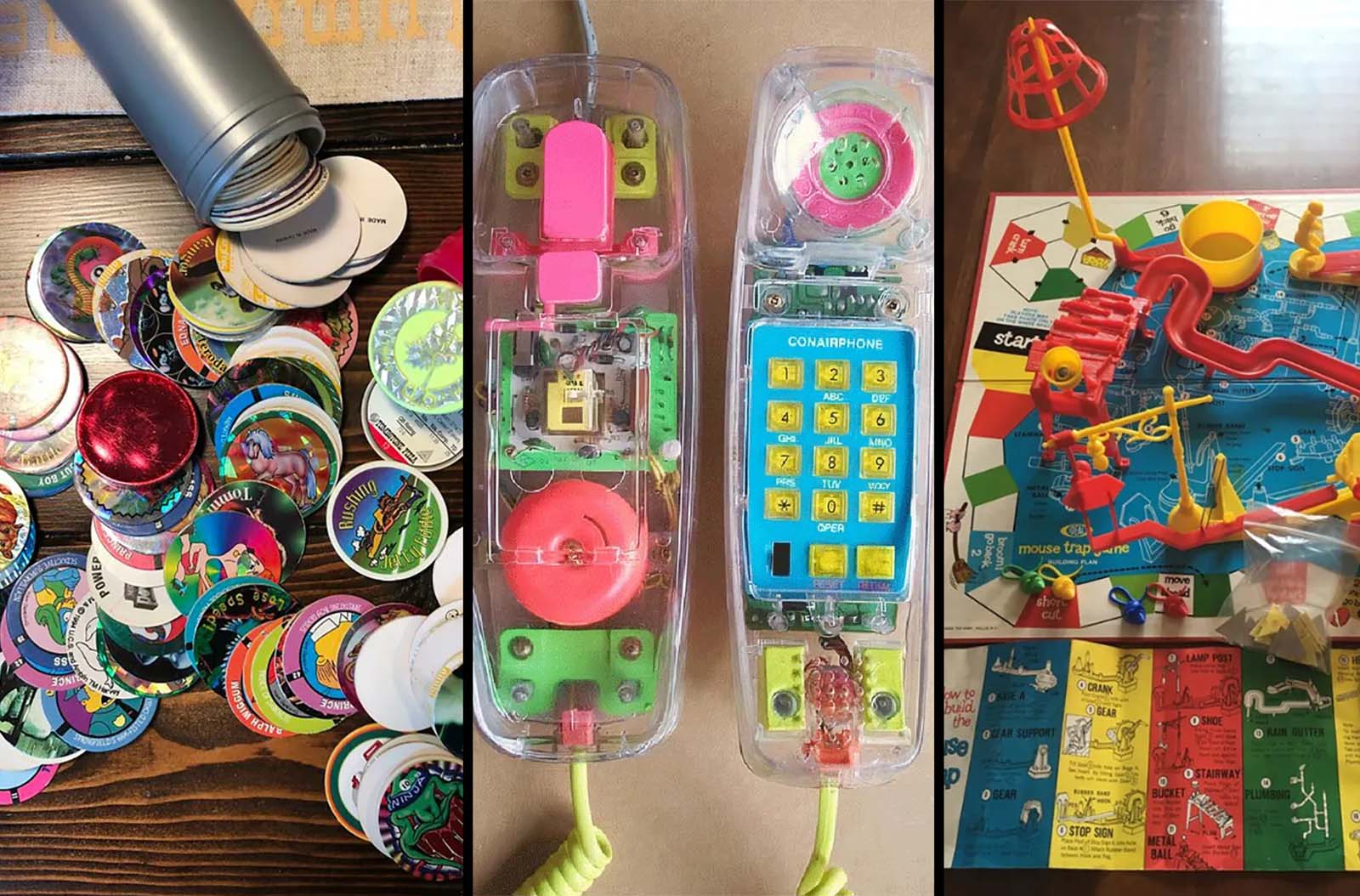
Embark on a captivating journey through time as we delve into the enchanting world of vintage toys.
In this article, we invite you to revisit the cherished toys of bygone eras, each a testament to the enduring appeal of childhood imagination and creativity.
From the timeless charm of the Easy-Bake Oven to the strategic allure of the Simon Game, these vintage treasures offer a glimpse into the playtime experiences of generations past.
Explore the whimsical realm of Neon Klickers Clackers, the surprise-filled Kinder Surprise Toys, and the mesmerizing Magic Etch-A-Sketch.
Through the lens of nostalgia, we aim to revive the simple joys and cherished memories associated with these vintage treasures, inviting you to connect with the past while relishing the timeless magic of play.
The enduring appeal of these toys lies in their ability to transcend time, sparking fond recollections and evoking a sense of nostalgia that unites us across the years.
Game Boy
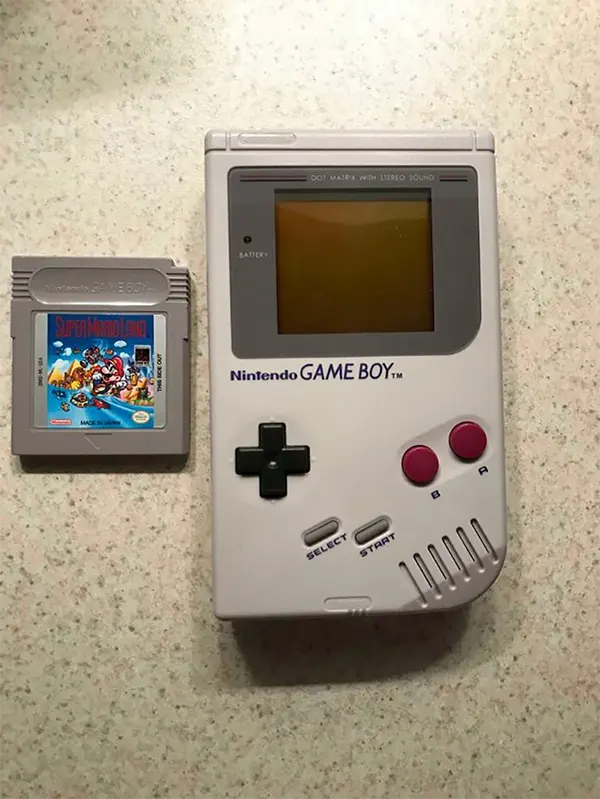
In 1989, Nintendo launched the Game Boy—a handheld device that would transform gaming.
Designed by Gunpei Yokoi, its compact size belied its impact. With its grayscale screen and green tint, the Game Boy introduced portable gaming to the masses.
“Tetris,” bundled with the device, marked a turning point, showcasing its appeal and versatility.
Titles like “Super Mario Land” and “Pokémon Red and Blue” further cemented its popularity, sparking a handheld gaming revolution.
Slinky

The Slinky is a classic children’s toy that consists of a helical spring made from metal. It was invented by Richard James in the early 1940s and was introduced to the public in 1945.
The Slinky’s simple yet captivating design allows it to perform a unique and entertaining trick – it can “walk” down stairs or a slope by itself, thanks to its coil-shaped structure and the forces of gravity.
The Slinky quickly gained popularity and became an iconic toy in the United States and around the world.
Its mesmerizing motion and the tactile sensation of manipulating the spring made it a favorite among kids and adults alike.
It was initially marketed as a novelty toy and quickly became a sensation, with millions of units sold in its early years.
Koosh Balls

Koosh Balls are a type of novelty toy made from a soft, rubbery material with numerous rubber strings radiating outward from a central core.
They were invented by Scott Stillinger in the late 1980s and gained significant popularity in the early 1990s.
The distinctive feature of Koosh Balls is their unique texture and tactile sensation. The rubber strings are typically made of latex material, which gives the ball a squishy, stretchy, and pleasantly pliable feel.
The design of Koosh Balls allows for a variety of interactive and sensory play experiences. They can be squeezed, pulled, tossed, and even caught due to their soft and lightweight construction.
Crayola Stamper Markers

Crayola Stamper Markers are a creative and colorful art tool designed for children. These markers combine the functionality of traditional markers with the added fun of stamping designs.
Each Crayola Stamper Marker has a stamping tip at one end, allowing users to create vibrant drawings and add stamped patterns or images to their artwork.
Playmates Fun-to-Drive Corvette Dashboard

The Playmates Fun-to-Drive Corvette Dashboard was a popular toy released in the 1980s that allowed children to simulate driving a miniature Corvette sports car.
It was a part of the larger trend of electronic toys and gadgets that aimed to provide interactive and immersive experiences for young users.
The toy consisted of a dashboard-shaped console with various buttons, switches, and a steering wheel.
It was designed to resemble the dashboard of a Corvette, complete with a speedometer, gas gauge, and other realistic-looking controls.
The steering wheel was the centerpiece of the toy, allowing children to imagine themselves navigating the open road.
Tamagotchi

Tamagotchi is a virtual pet simulation toy that became a worldwide sensation in the 1990s. It was created in Japan by Aki Maita and released by Bandai in 1996.
The name “Tamagotchi” is a combination of two Japanese words: “tamago,” meaning egg, and “watchi,” which is a variation of the word for friend. The name aptly describes the toy’s initial form as an egg-shaped device with a virtual pet inside.
The Tamagotchi device features a small LCD screen and three buttons that allow users to interact with and care for their virtual pet.
Players are responsible for feeding, cleaning up after, and nurturing their digital pet, which goes through various life stages, such as hatching from an egg, evolving into different forms, and eventually aging.
Flying Gliders

Flying gliders, also known as paper airplanes or simply gliders, are toys that are designed to fly through the air without the need for power sources like engines or motors.
They are typically made from lightweight materials such as paper, foam, or plastic.
Fisher Price Set

Fisher-Price initially gained recognition for introducing durable, safe, and imaginative wooden toys.
Over the years, the company expanded its product line to include a diverse array of toys, games, and products designed to engage and entertain young children while promoting their cognitive, physical, and social development.
Pogs

Pogs were a popular collectible toy and game that gained immense popularity in the 1990s, particularly among children and teenagers.
The term “pog” originally referred to a brand of juice caps, but it evolved into a game that involved collecting and playing with circular cardboard discs.
View-Master Mickey 3-D Set

The View-Master Mickey 3-D Set was a children’s toy that combined the classic View-Master viewer with reels featuring 3D images of Disney’s Mickey Mouse.
The View-Master viewer resembled binoculars and allowed users to experience 3D images by rotating reels with a lever.
The set included reels with 3D images of Mickey Mouse and other Disney characters, providing an interactive and captivating form of entertainment.
As users looked through the viewer and advanced the reel, they could enjoy short 3D stories and scenes from Mickey Mouse cartoons.
Waterful Ring-Toss
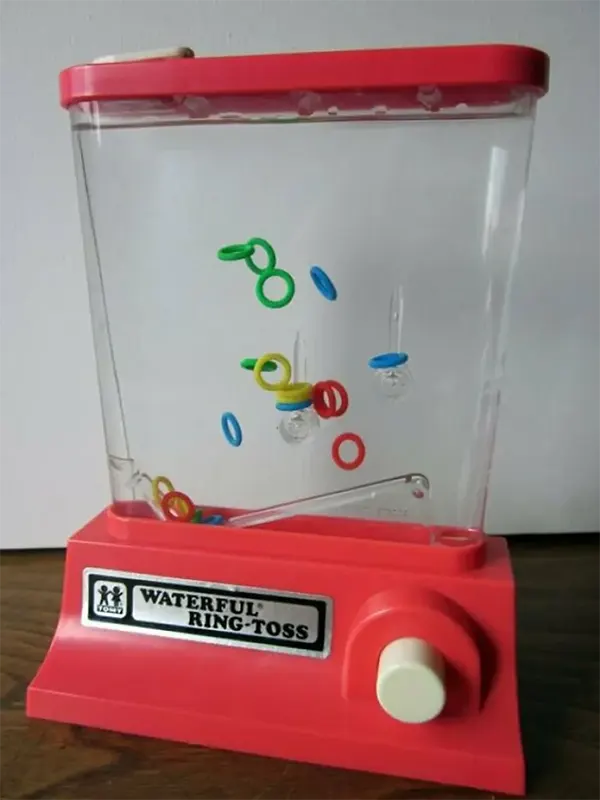
The Waterful Ring-Toss, introduced by TOMY in the 1970s, was a compact handheld toy designed for engaging play. It featured a sealed water chamber and plastic rings.
Players manipulated the water inside by pressing buttons or blowing air, causing the rings to float and move. The objective was to skillfully guide the rings onto pegs, scoring points.
The colorful rings’ movement in the water created a visually captivating display. The Waterful Ring-Toss offered portable and tactile entertainment, leaving a nostalgic memory of simple yet engaging play experiences.
Let’s Go Fishin’
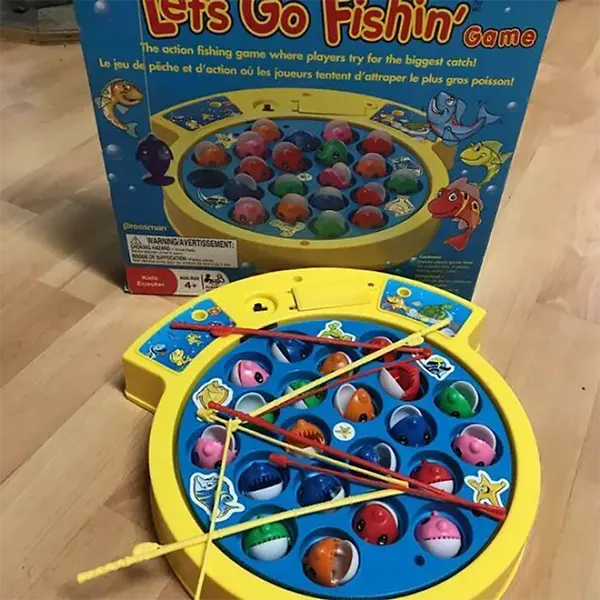
“Let’s Go Fishin’” is a beloved children’s game involving magnetic fishing rods and rotating plastic fish on a game board. Players use the magnetic rods to catch fish as they circle with open mouths.
The game enhances hand-eye coordination and fine motor skills, making it a hit among preschoolers and young children. The objective is to catch the most fish, adding an element of friendly competition.
Magic Etch-A-Sketch

The Magic Etch-A-Sketch, an evolution of the iconic Etch-A-Sketch toy, introduced a captivating twist to the traditional drawing experience.
While preserving the fundamental knobs-and-stylus concept of its predecessor, the Magic Etch-A-Sketch added a contemporary dimension by integrating vibrant, glowing effects into the artistic process.
By turning the knobs, users could guide the stylus to etch lines onto an illuminated screen.
Unlike the monochromatic lines of the classic Etch-A-Sketch, the Magic version allowed for the creation of drawings and designs using a spectrum of colors that emanated a mesmerizing glow.
This innovation not only retained the challenge of the original toy but also introduced an element of visual enchantment.
Bouncy Balls From Quarter Vending Machines and Arcades

Bouncy balls from quarter vending machines and arcades were small, vibrant rubber or plastic balls known for their unpredictable bouncing.
These novelty items, typically 1 to 2 inches in diameter, were popular among children and were often collected due to their different colors and patterns.
Dispensed from quarter-operated vending machines found in places like arcades and malls, they provided simple yet entertaining play. The unique bouncing behavior added an element of surprise and fun as they ricocheted off surfaces.
Fashion Plates

Fashion Plates were a popular arts and crafts toy that allowed kids to design fashion outfits. The set included plates with clothing elements like tops, bottoms, and accessories.
Users layered these plates and placed the paper on top, then rubbed a crayon or pencil to transfer the designs onto the paper, creating fashion sketches.
The mix-and-match plates enabled countless outfit combinations, fostering creativity and artistic exploration. Themed sets and accessories like hairstyles added to the fun.
Clear Plastic Neon Conair Phone

The Clear Plastic Neon Conair Phone was a translucent toy designed to resemble a real phone.
Made of transparent plastic in vibrant neon colors, it featured buttons, a keypad, and a receiver, though it wasn’t functional as a telephone.
Children used it for imaginative play, pretending to dial numbers and engage in phone conversations.
The toy provided a creative platform for practicing communication and social skills through role-play. Its colorful design and tactile buttons made it visually appealing and enjoyable for kids to mimic adult interactions.
Monster Finger Puppets

Monster Finger Puppets were small, colorful toys designed to fit onto fingers, resembling imaginative monster characters.
Made from soft materials like fabric or rubber, these puppets came in various shapes and colors, featuring details such as googly eyes.
Children could slip them onto their fingers, bringing the characters to life through interactive play.
Polly Pocket

Polly Pocket was a popular line of miniature doll playsets introduced in the late 1980s. Created by Bluebird Toys and later acquired by Mattel, these sets featured tiny dolls and intricate environments that unfolded from compact cases resembling makeup compacts or purses.
Each set had themed scenes, allowing kids to arrange the miniature Polly Pocket dolls and engage in imaginative play.
The small size, interactive features, and distinctive compact design made Polly Pocket a beloved and iconic toy that captured the hearts of many children.
Lite Brite

Lite-Brite was a creative toy that allowed children to create illuminated designs using small, colored plastic pegs on a backlit board.
Introduced in the 1960s, it consisted of a blackboard with a grid of small holes, and users inserted pegs into the holes to form pictures or patterns.
When the board was lit from behind, the pegs would glow, creating colorful and visually striking compositions.
Lite-Brite provided a hands-on and artistic way for children to explore light, color, and design, fostering creativity and imagination.
It quickly became a popular and nostalgic toy, with variations and updates introduced over the years to keep the concept relevant and engaging for new generations of young artists.
Troll Dolls

Troll Dolls were a whimsical and collectible toy line characterized by their unique, colorful appearance and wild hair.
Originating in the 1960s, these small plastic dolls featured exaggerated features like large eyes and distinct facial expressions. One of the most notable features was their vibrant, often spiky hair that could be styled in various ways.
Troll Dolls gained widespread popularity in the 1990s, becoming a cultural phenomenon.
They were collected, traded, and adorned with different outfits and accessories. The dolls came in various sizes, from keychain versions to larger figures.
Another View-Master

Play-Doh

Play-Doh is a renowned and versatile modeling compound that has provided creative play opportunities for generations of children.
Introduced in the mid-20th century, Play-Doh is a pliable and colorful dough that can be molded, shaped, and sculpted into a wide range of forms.
It has been a staple in the toy industry, offering kids a hands-on way to express their imagination and artistic ideas.
One notable Play-Doh set is the “Fuzzy Pumper Barber and Beauty Shop.” Released in the 1970s, this set allowed children to engage in pretend play as hairstylists and barbers.
The set included a plastic playset resembling a salon, complete with a chair, mirror, and accessories.
Lego Ghost
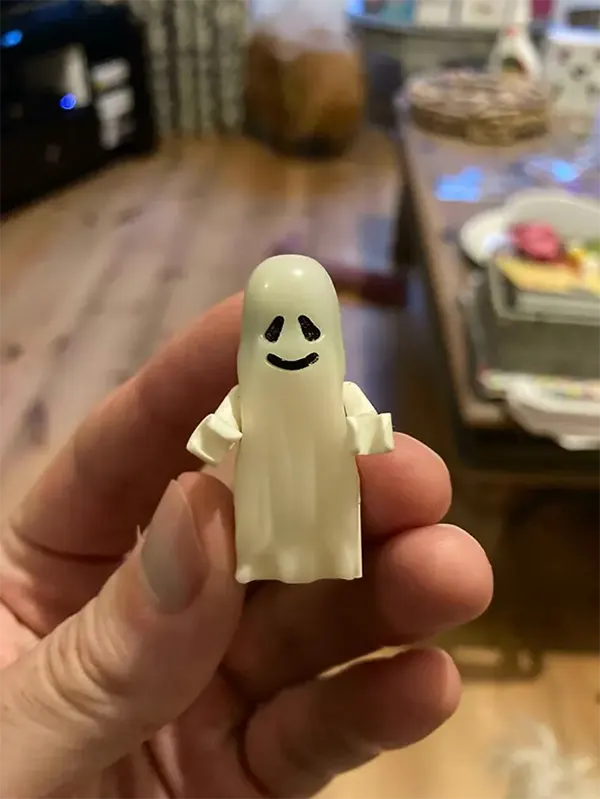
“Lego Ghost” refers to a specific type of LEGO toy set that features ghostly and supernatural themes.
These sets are part of the larger LEGO brand, known for its interlocking plastic bricks that allow users to build various structures and designs.
The LEGO Ghost sets often include haunted houses, spooky characters, and eerie accessories, offering a unique and imaginative play experience.
One notable example is the LEGO Ghostbusters line, which is based on the popular Ghostbusters franchise.
These sets allow fans to build iconic scenes and vehicles from the movies, such as the Ghostbusters’ headquarters, the Ecto-1 car, and various supernatural creatures.
Glittery Sand Lizards

This was a type of novelty toy that combined the fascination of lizards with the tactile appeal of sand play and a touch of sparkle.
These toys typically consisted of small plastic lizard figures coated with a layer of glittery sand-like material. The result was a visually captivating and texturally interesting play experience for children.
Micro Machines
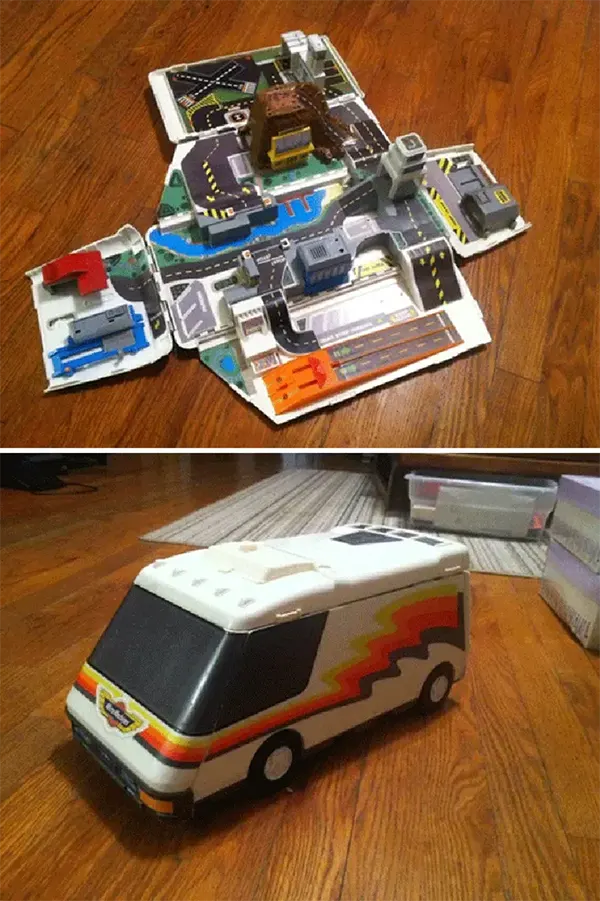
Micro Machines were a popular line of miniature toy vehicles and playsets created by Galoob (later acquired by Hasbro) in the late 1980s and 1990s.
These tiny vehicles, ranging from cars and trucks to airplanes and boats, offered a compact and detailed play experience.
The key feature of Micro Machines was their small size, which allowed for intricate designs and the ability to collect and play with numerous vehicles.
These sets were designed to resemble everyday environments like cities, construction sites, or race tracks.
Despite their small scale, the playsets were rich in details and features, offering miniaturized worlds for imaginative play. Some playsets also had transforming elements, allowing kids to change the setup and create different scenarios.
Magic Ball And Mitt Game

The Magic Ball and Mitt Game was a classic outdoor playset that included a rubber ball and a mitt or paddle. Players would stand apart and take turns tossing the ball to each other, using the mitt to catch and throw it back.
The game encouraged physical activity, coordination, and social interaction as players engaged in friendly back-and-forth play.
Its simple yet effective design made it a popular choice for outdoor fun, offering an active and entertaining way for children to enjoy shared playtime.
Easy-Bake Oven
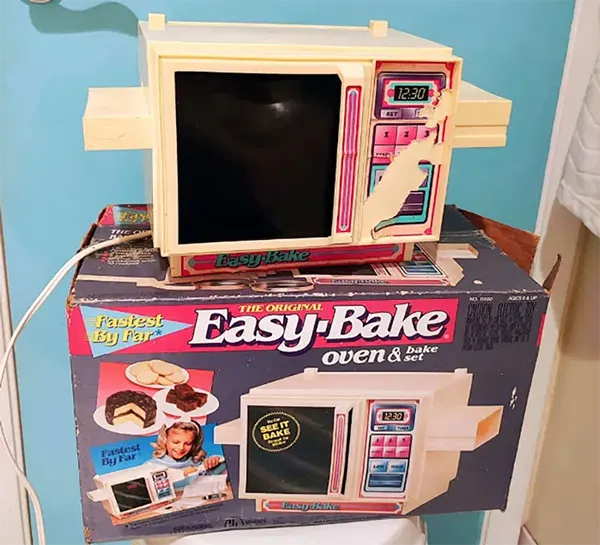
The Easy-Bake Oven was a beloved children’s toy introduced by Kenner (later acquired by Hasbro) in the 1960s. It allowed kids to experience the joy of baking and creating miniature treats.
The oven was designed to be safe and easy to use, featuring a heating element that allowed small cakes and other baked goods to be prepared using special pre-packaged mixes.
The concept was simple yet captivating: children would mix the ingredients provided in the kits, pour the batter into miniature pans, and then slide them into the Easy-Bake Oven.
The heating element would then bake the treats, allowing kids to watch the transformation through a small window. Once baked, the mini treats could be removed and enjoyed.
McDonald’s Happy-Meal Transformers

McDonald’s Happy Meal Transformers were miniature toy figures based on the iconic Transformers franchise.
These toys, offered as part of the Happy Meal promotions, allowed kids to experience the thrill of shape-shifting robots in a compact and collectible form.
The toy line featured various plastic figures representing Transformers characters, designed for easy manipulation by young hands.
While simpler than the traditional Transformers toys, they retained the fundamental transformation feature, enabling kids to switch the figures from robot to vehicle modes.
Simon Game
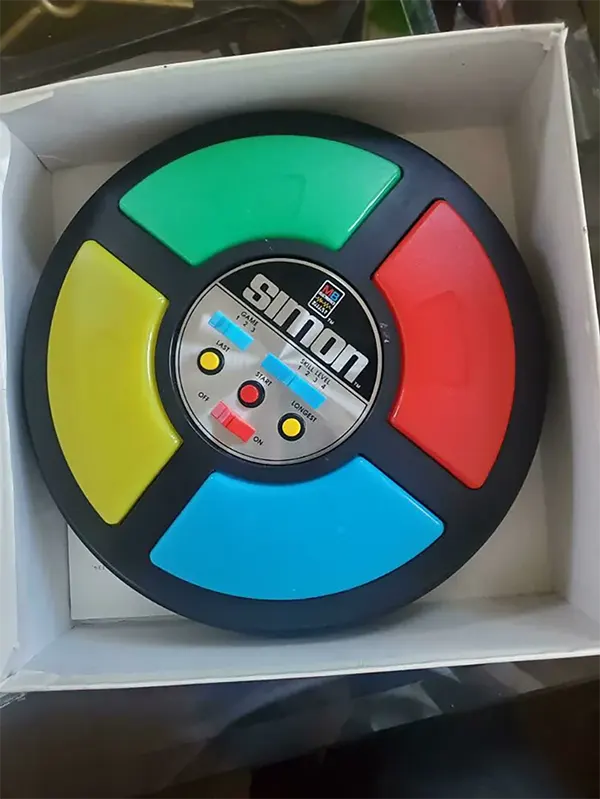
The Simon Game, introduced in 1978, was an electronic memory game that challenged players’ pattern recognition and concentration skills.
Designed by Ralph Baer and Howard Morrison, the game featured a circular device with colored sections—red, blue, green, and yellow—each associated with a button that emitted a unique sound and lit up when pressed.
Players aimed to replicate increasingly complex sequences of lights and sounds by pressing the corresponding buttons in the correct order.
As the game progressed, the sequences became longer and more challenging, testing players’ ability to memorize and reproduce patterns accurately.
Rubber Poppers

Rubber Poppers were a classic toy that offered simple yet amusing play. Introduced in the late 1970s, these small, rubbery toys were characterized by their round shape and ability to “pop” when inverted and placed on a surface.
When flipped, Rubber Poppers would briefly invert and then pop back up into the air, often surprising and delighting children with their unpredictable movements.
The design of Rubber Poppers was uncomplicated yet effective.
Each popper featured a concave base and a convex top, creating a shape that allowed it to flip inside out and then spring back into its original form. This motion was achieved through the toy’s flexible material and shape.
Mouse Trap

Mouse Trap was a classic board game first introduced in the 1960s by Ideal Toy Corporation. Designed for 2 to 4 players, the game combined elements of strategy, chance, and mechanical gameplay to create an engaging and entertaining experience.
The objective of Mouse Trap was to build a Rube Goldberg-inspired contraption to capture opponents’ mouse-shaped game pieces.
Players took turns moving around the game board, collecting cheese tokens, and constructing the elaborate mousetrap using various game components like plastic gears, ramps, and a metal ball.
The gameplay culminated in a climactic moment when the trap was triggered, setting off a chain reaction that ultimately resulted in the capture of a mouse game piece.
Fisher Price Adjustable Skates

Slime

Slime is a stretchy and gooey toy material that has captivated generations of children with its unique texture and playful qualities.
Introduced in the 1970s, slime is often made from a combination of ingredients such as glue, borax, and water, resulting in a viscoelastic substance that can be stretched, squeezed, and molded.
The allure of slime lies in its tactile and sensory nature. Children are drawn to its squishy and malleable properties, which provide a satisfying and enjoyable sensory experience.
Slime can be manipulated in various ways, encouraging imaginative play as kids shape it into different forms, stretch it, and experiment with its consistency.
Slime’s popularity has led to a wide range of variations, including different colors, textures, and even scents.
Some versions include glitter, beads, or other small objects to enhance the sensory experience.
Neon Klickers Clackers

Clackers were a type of popular toy in the 1970s. These toys consisted of two colorful, hard plastic balls, each attached to a string.
The balls were swung up and down in a rhythmic motion, creating a distinctive clacking sound when they hit each other.
The objective of Klickers was to create a smooth, clicking rhythm by skillfully maneuvering the balls in an alternating motion.
This required coordination and practice, as getting the timing right was essential to produce the satisfying clacking sound.
Silly Putty
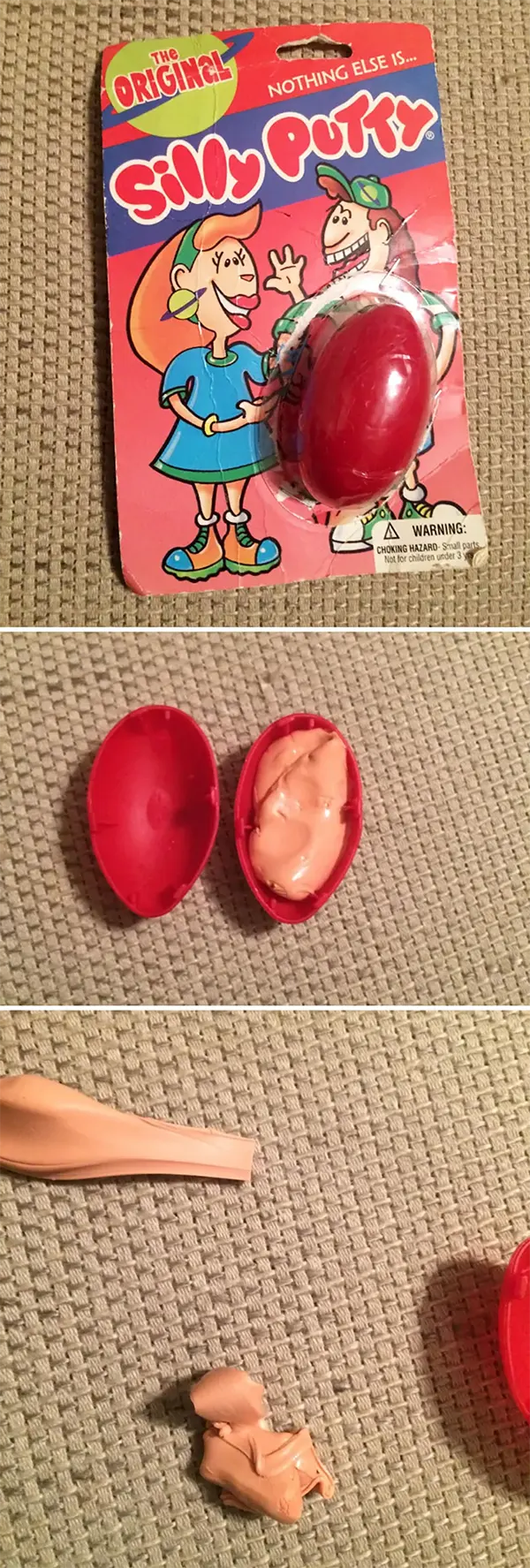
Silly Putty is a classic and iconic toy introduced in the 1950s. It’s a stretchable, malleable, and bouncy substance that has entertained generations of children and adults alike.
Originally developed as a failed attempt at creating a synthetic rubber substitute, Silly Putty quickly found a new purpose as a fun and engaging play material.
Silly Putty’s unique properties allow it to be molded into various shapes, stretched, bounced, and even used to pick up images from newspapers and comics.
When pressed onto printed material, Silly Putty would transfer the ink, creating a whimsical and distorted image that could be stretched and manipulated further.
The toy’s tactile appeal and versatile play possibilities made it an instant hit. It was packaged in small plastic eggs, adding to its novelty and portability.
Plastic Tube With Water And Plastic Fish Inside It
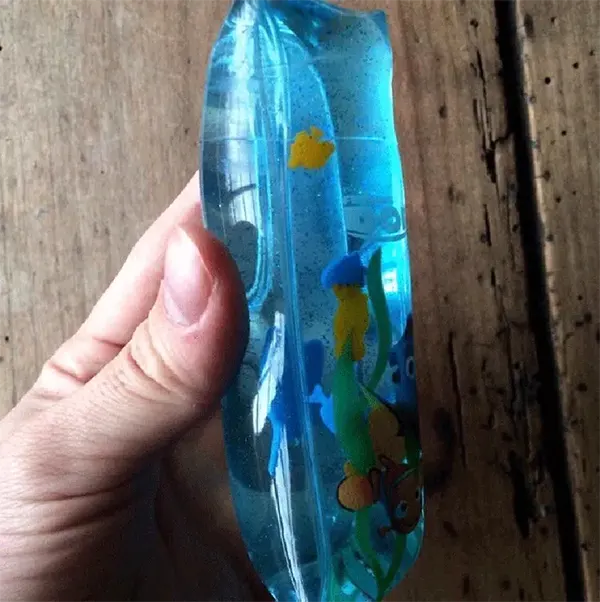
Kinder Surprise Toys
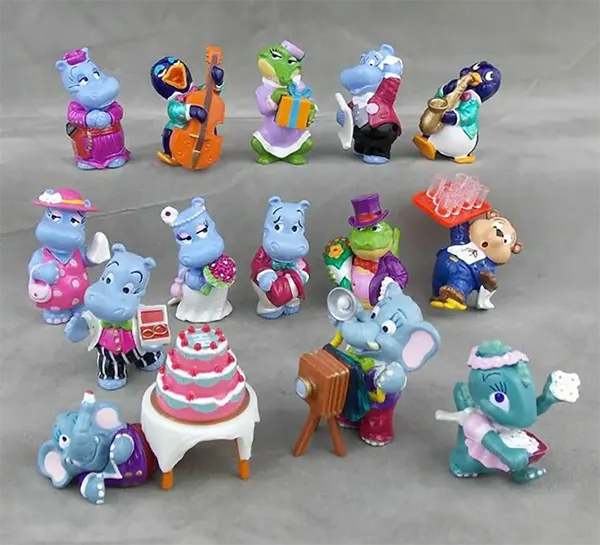
Kinder Surprise Toys, also known as Kinder Eggs, were delectable confections created by Ferrero in the 1970s.
These treats consisted of a hollow milk chocolate shell encasing a small plastic capsule containing a surprise toy.
The thrill of opening a Kinder Egg to unveil the hidden toy inside made them a beloved delight for children worldwide.
Each Kinder Egg boasted a thin layer of milk chocolate that could be easily cracked open to reveal the concealed toy.
The surprise element added an extra layer of excitement as youngsters eagerly anticipated discovering which miniature treasure awaited them.
Garfield Phone
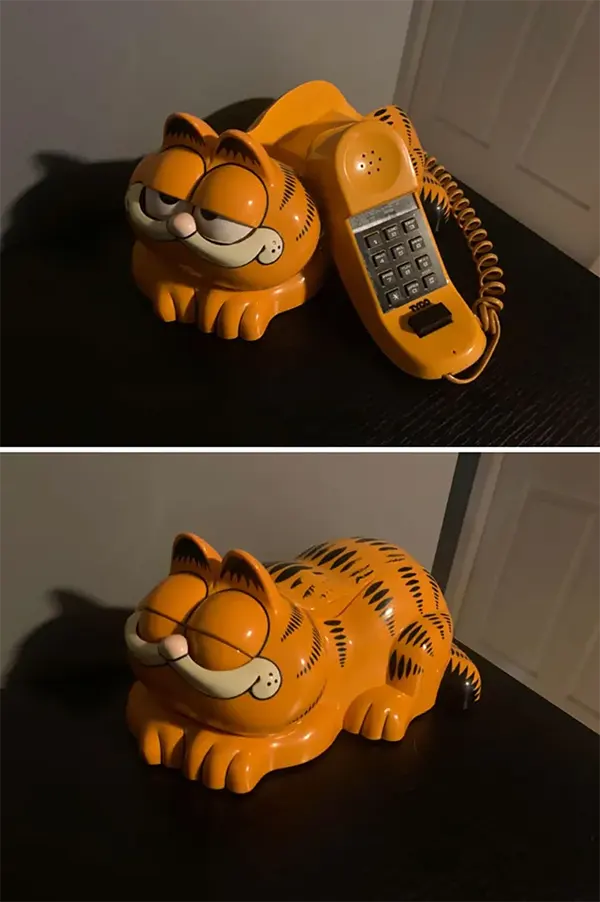
The Garfield Phone was a whimsical novelty telephone introduced in the 1980s. Shaped like the iconic comic strip character Garfield, the phone featured a plastic casing that resembled the lasagna-loving feline.
With the receiver placed on Garfield’s back and buttons integrated into the design, the phone offered a playful and humorous twist on a functional household item.
Blow Pens

Blow Pens were a creative art toy that gained popularity in the late 20th century. These innovative tools allowed children to create colorful and vibrant artwork by blowing air through specially designed markers.
The Blow Pens set typically included a variety of markers and stencils. To use them, a child would place a marker into a holder, then blow air through the opposite end, causing the ink to spray onto the paper.
Stencils added an extra dimension to the play, enabling kids to create intricate designs and patterns with ease.
The appeal of Blow Pens lay in their ability to produce smooth gradients and blending effects, making them particularly engaging for producing colorful backgrounds or intricate artwork.
Skip It
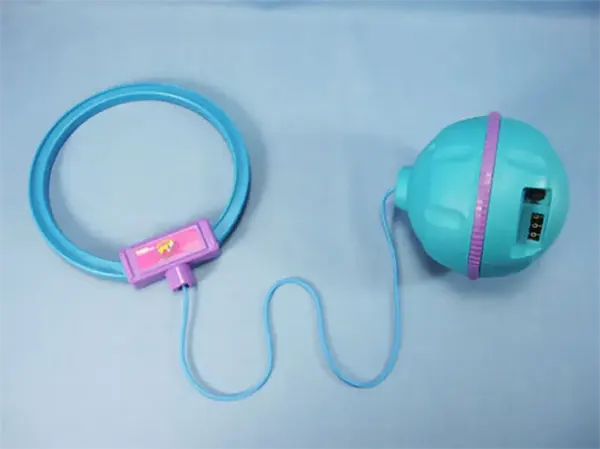
Skip It was a popular physical activity toy introduced in the 1990s. Designed for solo play, Skip It consisted of a weighted ball attached to an ankle loop by a rope.
The player would place the ankle loop on one leg and swing the ball in circular motions while hopping over it with the other leg.
The objective of Skip It was to maintain a continuous and rhythmic hopping motion without tripping over the rotating ball.
The toy featured a counter that tracked the number of successful skips, adding a competitive element as players aimed to achieve higher skip counts.
(Photo credit: Reddit / Pinterest / Flickr).
Updated on: August 9, 2023



